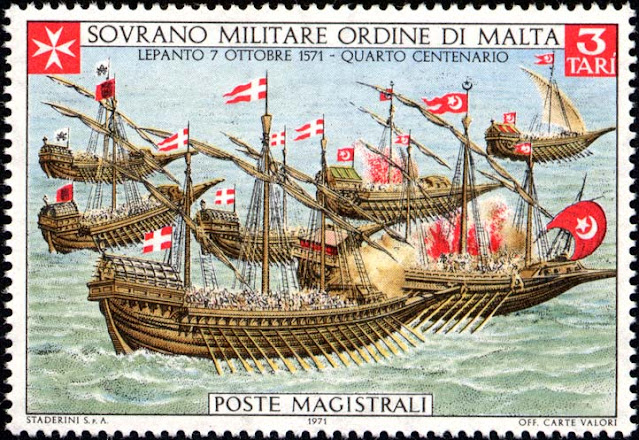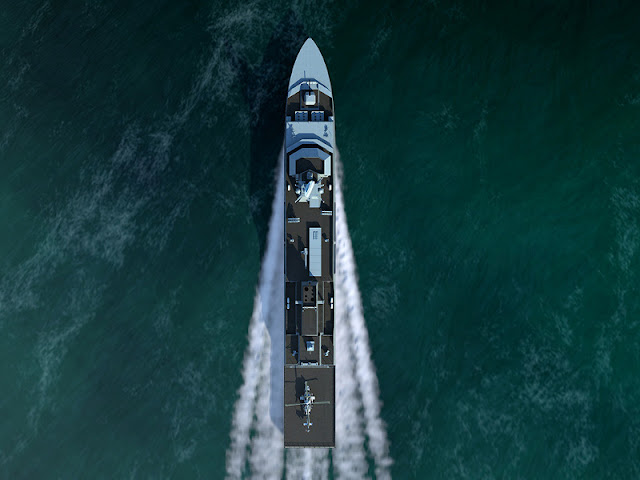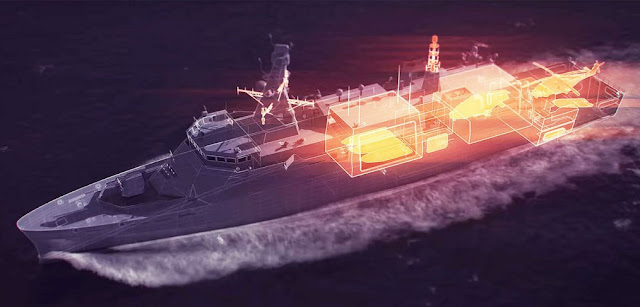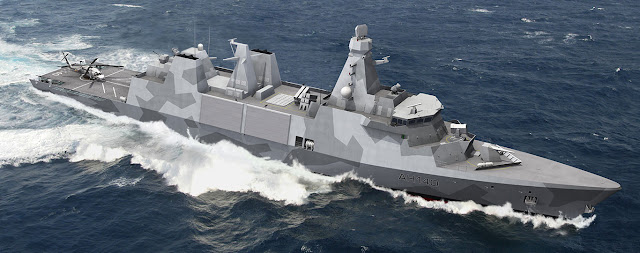Blog dedicato agli appassionati di DIFESA, militaria, sicurezza e tecnologia.
martedì 22 settembre 2020
7 ottobre 1571: la battaglia di Lèpanto
lunedì 21 settembre 2020
Emergono ulteriori dettagli sulle fregate “Arrowhead” Type 31 della Royal Navy
All'inizio del progetto della fregata Tipo 31, è stato sempre riconosciuto che la credibilità della nave dipendeva dagli armamenti imbarcati, dai sensori, oltre che dalla piattaforma stessa.
Il progetto Arrowhead selezionato dal Ministero della Difesa britannico è maturo, ma c'è ancora un altro anno di lavoro di progettazione dettagliata e la certificazione da completare.
Sebbene tutt'altro che esaurienti, sono ora disponibili alcuni dettagli delle nuove fregate della Royal Navy.
Il contratto formale tra il Ministero della Difesa e la Babcock sarà firmato entro la fine di quest'anno. Il lasso di tempo concordato vedrà il taglio delle lamiere nel 2021, la prima nave varata nel 2023 e la consegna delle cinque fregate tra il 2024 e il 2028. La Babcock ha confermato che investirà 50 milioni di sterline in capannoni coperti per la costruzione di navi a Rosyth che avrà il capacità di montare due fregate fianco a fianco. Con l'HMS Prince of Wales che salperà a breve da Rosyth, il futuro per il cantiere era piuttosto cupo: la Type 31 fornirà continuità di lavoro agli operai scozzesi per quasi un decennio.
L'investimento in nuove strutture indica forse anche che la Babcock ha fiducia di poter garantire ordini per l'esportazione per la costruzione; la marina polacca è nota per essere uno dei numerosi potenziali clienti della Arrowhead.
La Babcock afferma di essere disponibile a condividere il lavoro in tutto il Regno Unito in linea con la strategia nazionale di costruzioni navali. Sia Ferguson (Clyde) che Harland e Wolff (Belfast) facevano parte del consorzio originale del Team 31e ma sono attualmente in cattive condizioni. Ai membri del consorzio non è garantita una condivisione del lavoro, ma sarebbe consentito fare offerte per costruire blocchi delle sovrastrutture. La Babcock conferma che non correranno rischi con il programma e qualsiasi partner commerciale sarà soggetto alla consueta due-diligence finanziaria. I cantieri Cammell Laird ribadiscono che non sono legati esclusivamente all'offerta BAE Systems Leander e sarebbero aperti a lavorare sul Tipo 31.
Una variante per l'esportazione della fregata Arrowhead, sarà offerta come candidata per il requisito della fregata multiuso della Marina polacca.
Alcuni partner della catena di fornitura Arrowhead hanno già annunciato in anticipo il loro coinvolgimento e molti altri seguiranno presto. La Raytheon Anschütz produrrà il sistema di navigazione ed il ponte integrato per la nave Type 31, un sistema che è già imbarcato sui cacciatorpediniere Type 45 e adattato per la fregata Type 26.
David Brown Santaslo, che produce scatole del cambio per navi da guerra a Huddersfield, ha rivelato di essere stato contattato per costruire il treno di ingranaggi per il Type 31, sebbene sarà molto più economico e molto meno sofisticato di quelli che stanno costruendo per la Type 26.
Nell'era dell '"attacco a sciami" da parte di piccole imbarcazioni o UAV, l'artiglieria di calibro medio-leggero è tornata di moda.
Il Tipo 31 monterà almeno 3 moderni sistemi di cannoni che sono adatti per affrontare più piccoli bersagli.
L'arma più pesante sarà un cannone Bofors di medio calibro 57mm Mk 110 Mod 0 che è già in servizio con gli Stati Uniti e diverse altre marine. Può erogare fino a 4 colpi al secondo e ha una gittata di circa 17 km. L'intero sistema, inclusi 1.000 colpi, pesa circa 14 tonnellate. Questa è un'arma molto diversa dalla più pesante Mk 8 da 114 mm (4,5 ") che eroga un singolo proiettile ogni 2 secondi e ha equipaggiato la maggior parte delle fregate RN dagli anni '70.
Il Mk 110 non è ottimizzato per supportare le truppe a terra ma per obiettivi multipli e imprevedibili. È possibile riselezionare prontamente diversi tipi di munizioni, comprese le munizioni preframmentate, programmabili e di prossimità (3P). Ha un'utile modalità airburst per difendersi dagli sciami di barche, ma potrebbe passare alla difesa da aerei o missili usando spolette di prossimità o bersagli più pesanti usando spolette ad azione ritardata.
La sua alta velocità di fuoco significa che il 57mm fornisce effettivamente un peso maggiore di esplosivo sul bersaglio. Il supporto del cannone può contenere 120 colpi ma può essere rifornito da un equipaggio di 3 persone nel vano cannoni sul ponte sottostante.
Il Tipo 31 non sarà dotato del CIWS da 20mm Phalanx ma monterà invece due cannoni Bofors 40mm Mk 4. Questi supporti leggeri da 2,3 tonnellate possono sparare 5 colpi al secondo fino a circa 12,5 km e sono progettati per rispondere rapidamente a un'ampia gamma di obiettivi. Consegnando proiettili più pesanti più lontano dalla nave, l'Mk 4 è superiore al Phalanx. Forniscono difesa contro attacchi aerei e missilistici, ma utilizzano le stesse sofisticate munizioni di tipo 3P del 57mm, quindi possono cambiare rapidamente per ingaggiare piccole imbarcazioni o minacce UAV. 100 colpi sono tenuti nel cannone pronti a sparare con la possibilità di spostarsi tra diversi tipi di munizioni.
La Bofors è di proprietà di BAE Systems, quindi la decisione del Tipo 31 non è solo una cattiva notizia per l'azienda, con un ordine per almeno 15 sistemi di armi e munizioni in arrivo per la produzione in Scandinavia e negli Stati Uniti.
Il tipo 31 vedrà la gestione del combattimento Thales TACTICOS Baseline 2 installata per la prima volta su di una unità di superficie della RN. Questa è un'altra erosione del monopolio BAES su CMS, anche se alcuni si chiedono se sia saggio richiedere ai marinai di addestrarsi su un altro sistema. TACTICOS ha diversi punti di forza rispetto alle offerte BAES ed è progettato per essere molto intuitivo. Thales afferma che un tipico specialista di guerra potrebbe eseguire un cross-training sul sistema nello spazio di circa 5 settimane, sebbene le configurazioni differiscano notevolmente a seconda della piattaforma. TACTICOS è scalabile e la sua architettura aperta e la sua modularità consentono di aggiungere facilmente ulteriori profili di missione. Oltre al Sea Ceptor, Thales ha già esperienza nell'integrazione di TACTICOS con la maggior parte delle armi e sensori.
Il radar a medio raggio trasportato dal Tipo 31 sarà il Thales NS110 (o forse il più recente NS200 a lungo raggio che incorpora la tecnologia GaN). Questo è un radar 3D AESA multimissione in banda S che fornirà il controllo del fuoco per il Sea Ceptor e la sorveglianza aerea a lunga distanza. Con una portata fino a 110 nm fino a 70° di elevazione, ha un'elaborazione multiraggio a doppio asse che gli consente di tracciare più bersagli in ambienti litorali disordinati. Il radar è modulare e può essere adattato alle esigenze del cliente.
L'Artisan che equipaggia il Tipo 23/26 ha una portata simile e lavora nella banda E / F ma è scansionato meccanicamente, a differenza del raggio orientabile elettronicamente del radar Thales AESA. Almeno sulla carta, il Tipo 31 avrà un radar principale superiore all'Artisan del Tipo 26, sebbene quando insieme in un gruppo di attività può essere utile avere diversi tipi di sensori che possono mitigare i reciproci punti deboli. Per il controllo del fuoco è possibile che l'NS110 fornisca anche una guida per i cannoni.
Sia la Marina che il fornitore concordano sul fatto che il prezzo di 250 milioni di sterline copre completamente i costi di produzione e fornirà una nave da guerra completa. Ci sono altri costi nella costruzione di nuove navi da guerra e le prime aspettative erano che il Tipo 31 sarebbe stato fortemente dipendente dalle attrezzature fornite dal governo (GFE) per rientrare nel budget previsto.
Ogni elemento in servizio richiede la propria pipeline di formazione e supporto, quindi la comunanza è generalmente considerata una priorità. La Royal Navy dovrà ora supportare 3 nuovi sistemi di armi in servizio, ciascuno con le proprie munizioni. Il Tipo 26 è equipaggiato con il potente, ma molto costoso Mk 45 Mod 4 da 127 mm e il Tipo 31 introdurrà due nuovi calibri di cannone alla flotta.
Valutando nel complesso il progetto di questa fregata, sembra che sia ben armata per il suo ruolo previsto nei conflitti di bassa-media intensità. Per le operazioni di sicurezza marittima, è particolarmente ben equipaggiato pur essendo in grado di intensificarsi per difendere se stesso e altre navi da attacchi aerei e missilistici. I cannoni da 57 mm e 40 mm hanno una capacità di sovrapposizione, ma probabilmente un cannone principale più pesante sarebbe stato improponibile. Questa nave sarà in grado di lanciare intorno a sé un muro di schegge letali più velocemente di quanto si possa immaginare.
Il tipo 31 potrebbe anche rendere credibili scorte di secondo livello. La capacità antisommergibile sarà piuttosto limitata, probabilmente alla pari con un cacciatorpediniere di tipo 45, anche se questo potrebbe forse essere parzialmente mitigato in futuro con sistemi ASW senza equipaggio fuori bordo trasportati nelle baie delle barche. Un grande vantaggio della Arrowhead è il generoso margine di spazio e peso per aggiungere ulteriori armi e sensori, inclusi missili temporanei o futuri anti-nave / attacco terrestre.
13 fregate di tipo 26 potrebbero essere preferibili ma non sono convenienti. Il Tipo 31 dovrebbe fornire 5 fregate per poco più del costo di un singolo Tipo 26 diversificando la base industriale. Sebbene la Arrowhead sia tutt'altro che perfetta, la Royal Navy può essere soddisfatta che sta ottenendo una piattaforma credibile, dissipando presto i timori che il Tipo 31 possa fornire una corvetta riscaldata.
È probabile che le controversie tra i politici di Portsmouth e Plymouth su dove saranno basate le navi diventeranno più esplicite. Devonport è già stata nominata base per le 8 fregate Type 26 e ha ragione per meritarsi le Type 31, avendo perso i suoi sottomarini e la HMS Ocean. Le 5 fregate Tipo 23 "per uso generale" più vecchie vedranno il crepuscolo della loro carriera con sede a Portsmouth e si argomenta che basando la Tipo 31 ci sarebbe un sostituto simile. Portsmouth beneficia di essere sede di due grandi portaerei, ha i sei Type 45 e le MCVM di classe Hunt sopravvissute, forse ha senso fare di Devonport l'unica base delle fregate della marina.
Poiché la Marina militare sta aumentando il numero di navi schierate in prima linea, il tempo trascorso nel porto di origine diminuirà, riducendo leggermente l'importanza di dove si trovano.
Come il Tipo 26, l'Arrowhead non si adatta ai bacini di carenaggio coperti del Devonport Frigate Refit Complex. Potrebbe esserci un motivo per la Babcock che ingrandirà questa preziosa struttura per utilizzarla per manutenere entrambi i nuovi tipi di fregate. Come "loro" prodotto, BAE Systems sarebbe in una posizione forte per vincere i lavori di manutenzione per la fregata Tipo 26, ma probabilmente preferirebbe farlo nelle loro strutture esistenti a Portsmouth.
Possiamo anche aspettarci una vivace discussione sui nomi delle cinque navi. In tempi recenti il consiglio di amministrazione della Marina (con l'approvazione del Segretario di Stato) ha deciso i nomi delle navi molto prima della definizione della nave. L'ultima fregata Tipo 26 è già stata nominata HMS London più di 10 anni prima che inizi la sua costruzione. Il nome per il primo della classe è particolarmente importante poiché il nome della nave principale finirà per sostituire la nomenclatura Arrowhead / Type 31 di uso popolare.
ENGLISH
At the beginning of the Type 31 frigate project, it was always recognised that the ship's credibility depended on the equipment on board, the sensors, as well as the platform itself.
The Arrowhead project selected by the British Ministry of Defence is mature, but there is still another year of detailed design work and certification to complete.
Although far from exhaustive, some details of the Royal Navy's new frigates are now available.
The formal contract between the Ministry of Defence and Babcock will be signed by the end of this year. The agreed time frame will see the cutting of the plates in 2021, the first ship launched in 2023 and the delivery of the five frigates between 2024 and 2028. Babcock has confirmed that it will invest £50 million in covered sheds for the construction of ships in Rosyth which will have the capacity to fit two frigates side by side. With the HMS Prince of Wales soon to sail from Rosyth, the future for the yard was rather bleak: the Type 31 will provide continuity of work for Scottish workers for almost a decade.
The investment in new facilities perhaps also indicates that Babcock is confident it can guarantee export orders for construction; the Polish navy is known to be one of Arrowhead's many potential customers.
Babcock says it is willing to share the work across the UK in line with its national shipbuilding strategy. Both Ferguson (Clyde) and Harland and Wolff (Belfast) were part of the original Team 31e consortium but are currently in poor condition. Consortium members are not guaranteed to share the work, but would be allowed to bid to build superstructure blocks. Babcock confirms that they will not take any risks with the programme and any business partner will be subject to the usual financial due diligence. The Cammell Laird yards reiterate that they are not exclusively linked to the BAE Systems Leander offer and would be open to work on Type 31.
An export variant of the Arrowhead frigate will be offered as a candidate for the Polish Navy's multi-purpose frigate requirement.
Some partners in the Arrowhead supply chain have already announced their involvement in advance and many others will follow soon. Raytheon Anschütz will produce the navigation system and integrated deck for the Type 31 vessel, a system that is already onboard the Type 45 destroyers and adapted for the Type 26 frigate.
David Brown Santaslo, who manufactures gearboxes for warships in Huddersfield, has revealed that he has been approached to build the gear train for the Type 31, although it will be much cheaper and much less sophisticated than those being built for the Type 26.
In the era of "swarm attack" by small boats or UAVs, medium-light calibre artillery is back in fashion.
The Type 31 will mount at least 3 modern cannon systems that are suitable for smaller targets.
The heaviest weapon will be a Bofors medium calibre 57mm Mk 110 Mod 0 cannon which is already in service with the US and several other navies. It can deliver up to 4 rounds per second and has a range of about 17 km. The entire system, including 1,000 rounds, weighs about 14 tons. This is a very different weapon from the heavier 114mm (4.5") Mk 8 which delivers a single bullet every 2 seconds and has equipped most RN frigates since the 1970s.
The Mk 110 is not optimized to support troops on the ground but for multiple, unpredictable targets. Various types of ammunition can be readily re-selected, including pre-fragmented, programmable and proximity (3P) ammunition. It has a useful airburst mode to defend against swarms of boats, but could switch to aircraft or missile defence using proximity fuzes or heavier targets using delayed action fuzes.
Its high rate of fire means that the 57mm actually delivers more explosive weight on the target. The cannon mount can hold 120 rounds but can be supplied by a crew of 3 in the gun bay on the deck below.
The Type 31 will not be equipped with the 20mm Phalanx CIWS but will instead mount two 40mm Mk 4 Bofors 40mm cannons. These 2.3 tonne lightweight mounts can fire 5 rounds per second up to approximately 12.5km and are designed to respond quickly to a wide range of targets. Delivering heavier bullets further away from the ship, the Mk 4 is superior to the Phalanx. They provide defence against air and missile attacks, but use the same sophisticated 3P type ammunition as the 57mm, so they can change quickly to engage small vessels or UAV threats. 100 rounds are held in the cannon ready to fire with the ability to move between different types of ammunition.
Bofors is owned by BAE Systems, so the Type 31 decision is not just bad news for the company, with an order for at least 15 weapons and ammunition systems coming in for production in Scandinavia and the USA.
Type 31 will see Thales TACTICOS Baseline 2 combat management installed for the first time on an RN surface unit. This is another erosion of the BAES monopoly on CMS, although some are wondering whether it is wise to require sailors to train on another system. TACTICOS has several strengths over BAES offerings and is designed to be very intuitive. Thales says a typical war specialist could cross-train on the system in about 5 weeks, although configurations differ greatly depending on the platform. TACTICOS is scalable and its open architecture and modularity make it easy to add additional mission profiles. In addition to the Sea Ceptor, Thales already has experience in integrating TACTICOS with most weapons, sensors,
The medium range radar carried by the Type 31 will be the Thales NS110 (or perhaps the newer NS200 long-range radar incorporating GaN technology). This is an S-band multi-mission EASA 3D radar that will provide fire control for the Sea Ceptor and long range aerial surveillance. With a range of up to 110 nm up to 70° elevation, it has dual-axis multi-beam processing that allows it to track multiple targets in untidy coastal environments. The radar is modular and can be adapted to customer requirements.
The Artisan that equips the Type 23/26 has a similar range and works in the E/F band but is mechanically scanned, unlike the electronically steerable beam of the AESA Thales radar. At least on paper, the Type 31 will have a higher main radar than the Artisan Type 26, although when together in a group of activities it may be useful to have different types of sensors that can mitigate each other's weaknesses. For fire control the NS110 may also provide guidance for cannons.
Both the Navy and the supplier agree that the £250 million price fully covers production costs and will provide a complete warship. There are other costs involved in building new warships and the initial expectations were that the Type 31 would be heavily dependent on equipment provided by the Government (GFE) to meet the budget.
Each element in service requires its own training and support pipeline, so commonality is generally considered a priority. The Royal Navy will now need to support 3 new weapons systems in service, each with its own ammunition. The Type 26 is equipped with the powerful but very expensive 127mm Mk 45 Mod 4 and the Type 31 will introduce two new cannon calibres to the fleet.
Looking at the overall design of this frigate, it appears to be well armed for its expected role in low to medium intensity conflict. For maritime security operations, it is particularly well equipped while being able to intensify to defend itself and other ships from air and missile attacks. The 57mm and 40mm guns have an overlap capability, but probably a heavier main gun would have been impractical. This ship will be able to launch a wall of lethal shrapnel around it faster than you can imagine.
The Type 31 could also make second level stockpiles credible. Anti-submarine capacity will be rather limited, probably on a par with a Type 45 destroyer, although this could perhaps be partially mitigated in the future with unmanned outboard ASW systems carried in boat bays. A great advantage of the Arrowhead is the generous margin of space and weight to add additional weapons and sensors, including temporary or future anti-ship/land attack missiles.
13 type 26 frigates may be preferable but are not convenient. Type 31 should provide 5 frigates for little more than the cost of a single Type 26 by diversifying the industrial base. Although Arrowhead is far from perfect, the Royal Navy can be satisfied that it is getting a credible platform, soon dispelling fears that the Type 31 could provide a heated corvette.
It is likely that the controversy between politicians in Portsmouth and Plymouth over where the ships will be based will become more explicit. Devonport has already been named base for the 8 Type 26 frigates and is right to deserve the Type 31, having lost its submarines and HMS Ocean. The 5 older Type 23 "general purpose" frigates will see the twilight of their career based in Portsmouth and it is argued that basing the Type 31 would be a similar replacement. Portsmouth benefits from being home to two large aircraft carriers, has the six Type 45s and the surviving Hunt class MCVMs, perhaps it makes sense to make Devonport the navy's only frigate base.
As the Navy is increasing the number of ships deployed to the front lines, the time spent in the home port will decrease, slightly reducing the importance of where they are located.
Like Type 26, Arrowhead is not suitable for the covered dry docks of the Devonport Frigate Refit Complex. There may be a reason for the Babcock to enlarge this valuable structure and use it to maintain both new types of frigates. As "their" product, BAE Systems would be in a strong position to win maintenance work for the Type 26 frigate, but would probably prefer to do so in their existing facilities in Portsmouth.
We can also expect a lively discussion on the names of the five ships. In recent times the Navy's Board of Directors (with the approval of the Secretary of State) has decided the names of the ships long before the ship was defined. The last Type 26 frigate has already been named HMS London more than 10 years before its construction began. The name for the first in class is particularly important as the name of the main vessel will eventually replace the popular Arrowhead / Type 31 nomenclature.
(Web, Google, Wikipedia, savetheroyalnavy, You Tube)
BundesWehr: i veicoli da ricognizione e combattimento medio delle Forze speciali Defenture AGF 2 “MAMMOTH” 4 X 4.
https://svppbellum.blogspot.com/ Si vis pacem, para bellum (in latino: «se vuoi la pace, prepara la guerra») è una locuzione latina. Il Bun...

-
https://svppbellum.blogspot.com/ Si vis pacem, para bellum (in latino: «se vuoi la pace, prepara la guerra») è una locuzione latina. Il tag...
-
https://svppbellum.blogspot.com/ Blog dedicato agli appassionati di DIFESA, storia militare, sicurezza e tecnologia. La bandiera è un simb...
-
https://svppbellum.blogspot.com/ Blog dedicato agli appassionati di DIFESA, storia militare, sicurezza e tecnologia. La bandiera è un simb...

















































